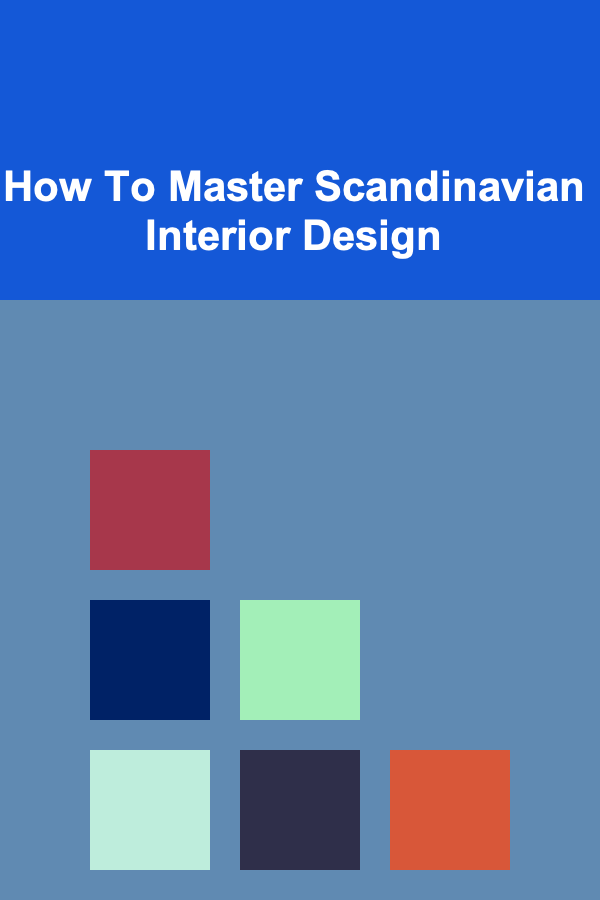
How To Master Scandinavian Interior Design
ebook include PDF & Audio bundle (Micro Guide)
$12.99$8.99
Limited Time Offer! Order within the next:

Scandinavian interior design has become one of the most beloved and influential styles in the world of interior decor. It is characterized by simplicity, functionality, and a focus on natural beauty. The style is deeply rooted in the cultures of Denmark, Sweden, Norway, and Finland, blending timeless design elements with practical living solutions. This article will explore the key principles and techniques involved in mastering Scandinavian interior design, from understanding its origins to implementing its core features in your own home.
Understanding the Roots of Scandinavian Interior Design
To truly master Scandinavian interior design, it's essential to first understand its origins. The style has evolved from a combination of practical necessities, cultural values, and a deep respect for nature, which have been interwoven over centuries. In its current form, it is a response to the harsh, cold climate of the Nordic region, emphasizing light, warmth, and simplicity.
The History Behind Scandinavian Design
Scandinavian design emerged in the early 20th century, although its roots can be traced back to earlier Scandinavian folk traditions. The modern movement gained significant traction in the 1950s, influenced by the growing need for more functional, minimalist living spaces in the wake of World War II. It was seen as a solution to the economic challenges of post-war Europe, where people were looking for ways to make homes both aesthetically pleasing and practical.
The design philosophy was first coined by Swedish architect Carl Larsson, whose paintings depicted simple yet elegant homes filled with natural light and understated furniture. Over time, this aesthetic evolved into a distinct style defined by its functionality, clean lines, and muted color palette.
Key Principles of Scandinavian Interior Design
The heart of Scandinavian design lies in the key principles of simplicity, functionality, and connection to nature. Below, we break down the most essential features that define the style.
1. Minimalism and Clean Lines
Scandinavian interior design is all about creating clean, uncluttered spaces. This is achieved through minimalism---removing unnecessary items and focusing on the essential elements. The design avoids excess decoration and ornate details, emphasizing simple, geometric forms. Furniture pieces, lighting, and accessories should have a streamlined look without being overly complicated.
How to Implement This:
- Opt for furniture with simple, functional forms. Choose pieces that blend seamlessly with your home and are aesthetically pleasing but not overwhelming.
- Avoid clutter and excess decoration. Instead, focus on a few key pieces that truly stand out.
- Utilize open shelving to keep spaces organized while maintaining a feeling of openness.
2. Functionality
In Scandinavian design, functionality is just as important as beauty. The furniture and layout of the space should be practical for everyday life. This focus on utility is not just about aesthetics but also about creating spaces that enhance comfort and make the most of every square inch.
How to Implement This:
- Choose multi-functional furniture, such as storage ottomans or foldable desks, to maximize space.
- Ensure that every piece of furniture serves a purpose. Avoid unnecessary decoration or items that do not add value to your daily life.
- Prioritize practical layouts, like open-plan spaces that encourage easy movement and fluidity.
3. Light and Airy Spaces
Given the long, dark winters in Scandinavia, light is a crucial aspect of Scandinavian interior design. Natural light is celebrated, and homes are designed to allow as much sunlight in as possible. Light colors and reflective surfaces are used to enhance the brightness of rooms, creating an airy and welcoming atmosphere.
How to Implement This:
- Use light-colored paints on walls, ceilings, and furniture. Whites, soft greys, and neutral tones are popular choices.
- Maximize natural light by using large windows or incorporating light, translucent window treatments like linen curtains.
- Add mirrors and reflective surfaces to amplify available light and create a sense of space.
4. Nature and Natural Materials
Scandinavians have a strong connection to nature, and this is reflected in their interior design. Natural materials such as wood, stone, wool, and leather are commonly used in Scandinavian interiors. These materials are not only visually pleasing but also evoke warmth and texture, bringing a piece of the outdoors inside.
How to Implement This:
- Incorporate wooden elements, whether it's through furniture, floors, or accents. Light woods like pine and birch are often used, though darker woods like oak can also make a statement.
- Use natural textiles such as wool for blankets, throws, and rugs, or linen for curtains and bedding.
- Add plants and greenery to your space, which not only beautifies but also contributes to a sense of calm and tranquility.
5. Neutral Color Palette
Scandinavian interiors tend to lean towards a neutral, muted color palette, with whites, greys, and earthy tones being the most common. This is done intentionally to create a calming, serene atmosphere. Pops of color are typically introduced through accessories, such as cushions, art, or rugs, rather than dominating the overall space.
How to Implement This:
- Choose neutral shades for walls and larger furniture pieces to create a clean backdrop. Soft whites, greys, and beige are ideal.
- Introduce subtle color through textiles, such as throw pillows, blankets, and wall art. Consider warm, muted colors like mustard, soft blues, or pastels.
- Keep the color palette simple and cohesive to maintain a calm and balanced atmosphere.
6. Hygge and Cozy Atmosphere
The concept of "hygge" (a Danish term meaning comfort, coziness, and contentment) plays a significant role in Scandinavian interior design. It's all about creating a warm, inviting space that feels like a sanctuary from the outside world. This is achieved through a combination of comfortable furniture, soft textures, and intimate lighting.
How to Implement This:
- Invest in cozy furniture pieces like plush sofas, armchairs, and oversized blankets.
- Layer different textures such as soft wool throws, faux fur cushions, and knitted fabrics to create a warm and inviting feel.
- Use soft lighting to create a cozy, relaxed ambiance. Consider floor lamps, table lamps, or candles, as well as overhead lighting with dimmers.
7. Craftsmanship and Quality
Scandinavian design places a high value on craftsmanship and quality. Furniture and decor are often built to last, with an emphasis on durable, well-made items. This doesn't mean that every piece needs to be an investment piece, but it does mean that quality should never be compromised for cheap alternatives.
How to Implement This:
- Choose furniture made from high-quality, sustainable materials. Scandinavian design values environmental responsibility, so opt for pieces that are durable and ethically produced.
- Invest in iconic pieces from renowned Scandinavian designers, such as Hans Wegner or Arne Jacobsen, to add both beauty and longevity to your space.
- Pay attention to the details in your home---look for items that are not only functional but also beautifully crafted.
Bringing Scandinavian Design to Your Home
Mastering Scandinavian interior design requires attention to detail and an understanding of its core principles. By focusing on simplicity, functionality, light, natural materials, and a cozy atmosphere, you can transform your home into a serene, inviting space that embodies the best of Scandinavian design.
1. Start with the Layout
Before you dive into purchasing furniture or decor, consider the layout of your space. Scandinavian interiors often feature open, flowing layouts that allow for easy movement and an airy feel. Look at the flow of your rooms and ensure that the space feels inviting and uncluttered.
2. Choose Quality, Simple Furniture
When it comes to furniture, choose pieces that are both functional and aesthetically pleasing. Scandinavian furniture tends to have clean lines and a minimalist design. Choose items that fit with your lifestyle, offering both comfort and practicality. A simple wooden dining table, a cozy sofa, and well-designed storage solutions are all essential pieces.
3. Lighten Up Your Space
Since Scandinavian homes emphasize natural light, make sure to prioritize windows and natural light sources. Remove heavy curtains and opt for light, airy window treatments. Also, incorporate artificial lighting that mimics natural light, such as soft LED bulbs or warm-toned light fixtures.
4. Incorporate Natural Materials
Wood, wool, linen, and other natural materials are staples in Scandinavian interiors. Bring these elements into your home by opting for wood furniture, stone flooring, and textiles made from natural fibers. Mixing textures will help create warmth and balance in your space.
5. Personalize with Accessories
Although Scandinavian design focuses on simplicity, that doesn't mean your space needs to be devoid of personality. Add a few personal touches with art, textiles, or handcrafted decor pieces that reflect your style. Just make sure to keep things minimal and intentional.
6. Embrace the Concept of Hygge
Create a cozy, welcoming atmosphere by incorporating soft textiles, warm lighting, and comfortable furniture. Whether it's curling up with a good book or enjoying a cup of tea by the fireplace, ensure your home feels like a retreat from the world.
7. Invest in Long-Term Design Choices
Scandinavian design places a premium on quality and longevity, so invest in pieces that are timeless and will stand the test of time. Whether it's a well-crafted chair or a piece of artwork, choose items that will stay with you for years to come.
Conclusion
Mastering Scandinavian interior design is not just about copying a look---it's about embracing a lifestyle that values simplicity, functionality, and a deep connection with nature. By following the principles of minimalism, light, and natural materials, you can create a space that is both beautiful and functional, offering you a peaceful and cozy environment to enjoy. Whether you're redesigning a single room or transforming your entire home, incorporating these elements will help you bring the timeless appeal of Scandinavian design into your life.

How to Organize Your Financial Life for Maximum Efficiency
Read More
How to Use Dimmer Switches to Control Your Home's Lighting
Read More
How to Use Remote Tech Support to Make Money
Read More
How to Lose Weight After Pregnancy
Read More
How to Develop a Workout Routine for Beginners
Read More
10 Tips for a Daily Schedule That Includes Creative Pursuits
Read MoreOther Products

How to Organize Your Financial Life for Maximum Efficiency
Read More
How to Use Dimmer Switches to Control Your Home's Lighting
Read More
How to Use Remote Tech Support to Make Money
Read More
How to Lose Weight After Pregnancy
Read More
How to Develop a Workout Routine for Beginners
Read More